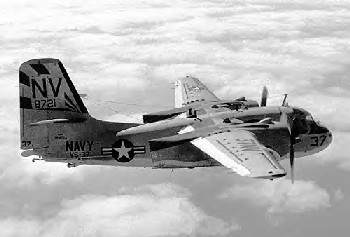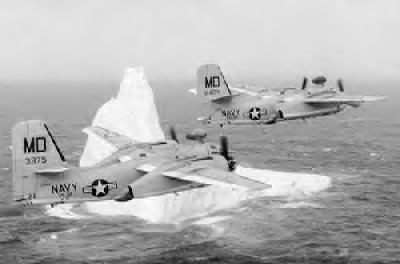Originally designated the S-2F-1 (later redesignated S-2A), and affectionately dubbed the "STOOF" (S-Two-F), the Tracker combined the hunter/killer (HUK) roles the Avenger and Guardian had been providing the US Navy previously. This also meant operating off of carriers, something its big brother the P-2 Neptune, and later the P-3 Orion, couldn't do.
The first prototype, XS-2F-1, flew December of 1952 and the type entered service February of 1954. A contemporary of such aircraft as the A-1 Skyraider, A-4 Skyhawk and the F-4 Phantom during the '50s and the '60's, it never received the glamorous attention these have garnered down to this day (I can count the number of Tracker model kits on one hand). But those who have been associated with it over the years generally have a soft spot for it in their hearts.
A total of six versions, S-2F-1 until S-2F-3S (S-2A - S-2E) were turned out with a final upgrade package bringing many S-2Es up to S-2G modification.
Trackers could work in conjunction with Navy helos utilizing dipping sonar, augmenting the Tracker's own sonobuoys. A radome, Magnetic Anomaly Detector (MAD) boom, Signal-Underwater-Sound (SUS) devices and a powerful searchlight completed its sensing package.
Torpedoes, depth charges and rockets were used for offensive measures, including its biggest "stick", a nuclear depth charge (the first and largest of these condemned the S-2C to its ungainly appearance, with enlarged bomb bay). Later models can ferry torpedoes, on hard points, under it wings.
The decks of many Essex-class aircraft carriers (dedicated to ASW duties) carried Trackers. As supercarriers later acquired a multirole configuration, Anti-Submarine Squadrons (VS) - now classified as Sea-control Squadrons - were seen on many more flight decks before the Tracker was phased out in the mid-seventies. At careers end, the Trackers had flown over six million hours, made almost three quarter million carrier landings, and had been the first aircraft to ride the steam powered catapult stroke, on the USS Hancock. It was at the front lines of a never realized World War III, during the Cuban missile crisis and suffered only one combated related loss, off the USS Hornet, in the Vietnam theather. This goes hand in hand with an overall accident rate of only 0.69 per 10,000 flighthours. The changing of the guard brought in the Lockheed S-3 Viking as its jet powered successor but the story doesn't end there….
Foreign country Trackers flew as contemporaries to the American versions and some still do today, in the role of maritime patrol and forest fire suppression.
 Backtracking its stateside lineage, the Tracker family included utility versions (US-2A/B/C and D) with a US-2 carrying America's first astronaut, Alan Shepard, back from the USS Lake Champlain recovery ship, and a trainer version, TS-2A. One photo reconnaissance RS-2C, and seven missile range clearing/Airborne Early Warning (AEW) aircraft, ES-2D, finally rounded out its stable. Modifications to the Tracker's original design brought about two cousins, the TF-1 (C-1A) Trader or the "Mailman of the Fleet", and the WF-2 (E-1B) Tracer, also known as "Willie Fudd" or "Stoof with a roof".
Backtracking its stateside lineage, the Tracker family included utility versions (US-2A/B/C and D) with a US-2 carrying America's first astronaut, Alan Shepard, back from the USS Lake Champlain recovery ship, and a trainer version, TS-2A. One photo reconnaissance RS-2C, and seven missile range clearing/Airborne Early Warning (AEW) aircraft, ES-2D, finally rounded out its stable. Modifications to the Tracker's original design brought about two cousins, the TF-1 (C-1A) Trader or the "Mailman of the Fleet", and the WF-2 (E-1B) Tracer, also known as "Willie Fudd" or "Stoof with a roof".
The Trader provided Carrier Onboard Delivery (COD) services, with NAS Quonset Point flying the only twin-tailed Trader. Four airframes were converted for Electronics Counter Measure (ECM) duties as the TF-1Q (EC-1A). The Tracer had an enlarged radome on the top of the fuselage, extending the eyes of the fleet, and giving it its signature piggybacked "Flying saucer" look.
Both were phased out in the mid-eighties and early seventies respectively. Greyhounds, even a handful US-3A's, and E-2 Hawkeyes carried on their duties.
In a sort of "spears to pruning shears" program, the Californian Department of Forestry's (CDF) acquisition of retired warbirds, for conversion to retardant bombers, included TS-2A's, phasing them in as the US Navy phased them out.
Property of the CDF, commercial operators provide pilots, mechanics and maintenance on a multi-year contract.
Considered a medium tanker, 800 gallons of retardant is its weapon of choice. Its new theater of combat is the hellish fires California fights every year. The Tracker can often been seen on television in fleeting glances during news coverage of these events. The State of Nevada has employed a different strategy in alleviating arid conditions. They used a US-2C in their cloud seeding program. Unfortunately this Tracker crashed April 2000 (for more details about this crash, see the US Navy gallery of this website).
One disadvantage it suffers is its being "short coupled". Having a short fuselage in relation to its wingspan, its nose pitches up severely when retardant is dropped (little warning is given when it stalls at low speed). Usually carrying one pilot, nine Firefighting Trackers have crashed, killing ten pilots in this service. A testament to its durability, though, can be found in one Tracker which lost 25% of one wing, and an aileron, and made it back safely.
A growing lack of engine parts has led to the development of turbine driven Trackers, the S-2T, or Turbo Tracker. Marsh Aviation, of Mesa, Az., began the first experimental conversion in 1986 for the CDF. Other companies have developed similar programs for Trackers aboard. Examples can be found in Canada (Conair) and Turkey (TAI). Trackers could be seen putting fires out over Turkey after its devastating earthquake struck in August 1999.
June 1, 1999 saw the first Turbo Tracker, called Firecat, enter the CDF fleet. Nineteen more will follow, with an added fifteen later on. The result of this conversion means greater speed, safety and a 1200 gallon retardant capability. Older Trackers are to be phased out by 2004.
 Manufacturer: Grumman
Manufacturer: Grumman
Powerplant: Two 1,525-hp Wright R-1820-82WA Cyclone 9-cylinder radial piston engines.
Weight empty: 18,750 lbs.
Max takeoff: 29,150 lbs.
Wing Span: 72ft. 7in.
Length: 43ft. 6in.
Height: 16ft. 7in.
Maximum Speed at Sea Level: 265 mph
Patrol Speed at 1,500 ft: 150 mph
Range: 1,300 miles
Armament: One Mk 57 or Mk 101 nuclear depth bomb or similar in bomb bay. 60 depth charges in fuselage, 32 sonobuoys in engine nacelles, six underwing hardpoints for bombs, rockets, or torpedos.